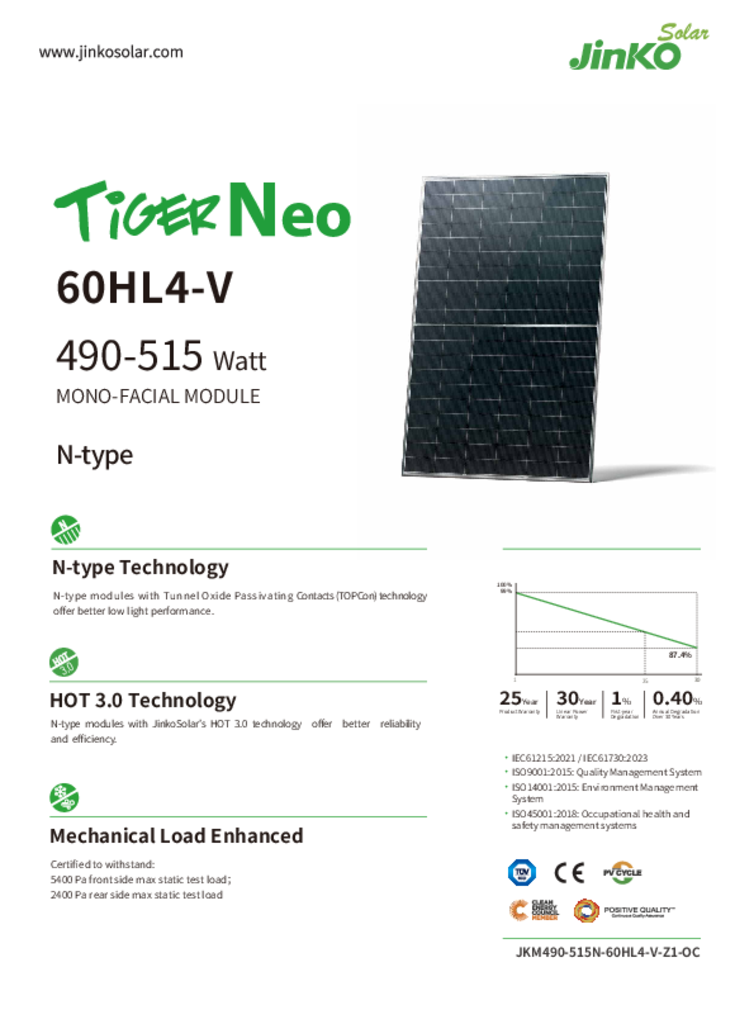
Jinko Tiger Neo N-Type 510W
GET A FREE QUOTE
QUICK REVIEW
The Jinko 510W Tiger Neo 120-Cell Solar Panel is a high-performance and versatile solution designed for residential, commercial, and off-grid applications.
Advanced N-Type Technology with TOPCon – Enhances low-light performance with tunnel oxide passivating contacts, maximising energy output.
Multi-Busbar (MBB) Solar Cell Design – Improves efficiency while maintaining a sleek, modern aesthetic.
High Module Efficiency – An impressive 23.60% efficiency, optimizing solar energy conversion.
Hot 3.0 Technology – Provides enhanced reliability and improved system performance.
Built for Extreme Weather – Certified to withstand heavy wind loads up to 2400 Pascal, ensuring long-term durability.
Minimal Degradation – Industry-leading low annual degradation rate of just 0.4% over 30 years, ensuring sustained power generation.
Comprehensive Warranty – 25-year product warranty and 30-year linear power warranty, offering long-term investment security.
Panel Technology: N-Type with Tunnel Oxide Passivating Contacts (TOPCon)
Module Efficiency: 23.60%
Module Type: JKM510N-60HL4-V
The Jinko Tiger Neo N-Type 60HL4-(V) 510W represents the latest advancement in premium solar panel technology, delivering superior efficiency, reliability, and durability.
The Jinko 510W Tiger Neo 120-Cell Solar Panel is a high-performance and versatile solution designed for residential, commercial, and off-grid applications. Built with advanced N-type monocrystalline cells, this panel ensures consistent energy output while maintaining an elegant design with its 30mm black frame.
Utilising half-cut cell technology, the panel effectively minimises energy loss and optimises performance, even in low-light conditions or partial shading. Equipped with multi-busbar (MBB) technology, it enhances power generation by reducing internal resistance, ensuring maximum efficiency.
Constructed for durability and reliability, the Jinko 510W Tiger Neo is built to withstand harsh weather conditions, making it an ideal choice for long-term energy solutions. Designed to reduce electricity costs and lower carbon emissions, this panel offers a premium combination of efficiency, aesthetics, and sustainability.
Key Features & Benefits:
Advanced N-Type Technology with TOPCon – Enhances low-light performance with tunnel oxide passivating contacts, maximising energy output.
Multi-Busbar (MBB) Solar Cell Design – Improves efficiency while maintaining a sleek, modern aesthetic.
High Module Efficiency – An impressive 23.60% efficiency, optimizing solar energy conversion.
Hot 3.0 Technology – Provides enhanced reliability and improved system performance.
Built for Extreme Weather – Certified to withstand heavy wind loads up to 2400 Pascal, ensuring long-term durability.
Minimal Degradation – Industry-leading low annual degradation rate of just 0.4% over 30 years, ensuring sustained power generation.
Comprehensive Warranty – 25-year product warranty and 30-year linear power warranty, offering long-term investment security.
Testimonials
What they are saying about us
F.A.Q
Frequently Asked Questions
-
What are the benefits of rooftop solar power?
There are many benefits in installing a solar PV system including:
- Reduce or eliminate your power bill - you can regain control of your electricity costs.
- A revenue generating asset - you make back many times the initial cost of the system over the lifetime of your solar PV system.
- Add value to your home - a solar system adds value to your home increasing the resale value.
- Reduce your carbon footprint - a solar system generates no greenhouse gases while in operation giving you zero carbon power and lowing your overall carbon footprint.
- Reduce or eliminate your power bill - you can regain control of your electricity costs.
-
What rebates can I get with my rooftop solar system? And how much are they worth?
Solar rebates come in three forms:
- Federal rebates: i.e. Small-scale Technology Certificates (STC) which are available in all states.
- State based rebates: Available in some states from time to time and may be means tested (you can email info@pure-electric.com.au for more details).
- Feed in tariffs: Different tariffs are offered by different retailers.
Small-Scale Technology Certificate (STC) rebate
Currently, all solar systems are eligible for an STC rebate which is calculated using four factors.
Factor 1: The total size of your system in kW
i.e. you have a 10 kW of panels and an 8.2 kW inverter your system size is considered 10 kW
Factor 2: The Zone you are in
Australia is divided into four solar zones.
Zone Rating 1 1.622 2 1.536 3 1.382 4 1.185 To find out which zone your postcode is in click this link.
Factor 3: The STC multiplier based on the year in which you install your solar system
The STC multiplier is a factor worked out based on what year you install your solar system and is as follows:
Factor 4: The price of STCs
STCs can be priced through the Government's STC clearing house or on the open market at places like Green Energy Markets.
As an example say that you are installing 10 kW of panels, in Zone 1 in 2020 and the current price of an STC is $35 your STC rebate would then be:
STC rebate = 10 x 1.622 x 11 x 35 = $6,244.70
This would appear as a $6,244.70 discount off the total cost of your solar system.
State specific rebates and Feed in Tariffs (FiT)
If you want to find out the currently available up-front rebates or Feed in Tarrifs (i.e. the amount you are paid for feeding power back into the grid) you can always email us at info@pure-electric.com.au for more details.
The following is a list of state government entities that manage state based solar incentive schemes:
- VIC - See the following website: https://www.solar.vic.gov.au
- SA - See the following website: https://www.sa.gov.au/topics/energy-and-environment/energy-efficient-home-design/solar-photovoltaic-systems
- WA - See the following website: https://www.wa.gov.au/organisation/energy-policy-wa/energy-buyback-schemes
- QLD - See the following website: https://www.qld.gov.au/housing/buying-owning-home/energy-water-home/solar
- ACT - See the following website: https://www.actsmart.act.gov.au/energy-saving/rebatessubsidies
- NSW - See the following website: https://energysaver.nsw.gov.au/households/solar-and-battery-power
- Federal rebates: i.e. Small-scale Technology Certificates (STC) which are available in all states.
Key Features
High Power Output (510W) – Delivers robust energy generation, meeting a wide range of solar needs.
Exceptional Module Efficiency (23.60%) – Optimises solar energy conversion for maximum performance.
Advanced N-Type Monocrystalline Cells – Ensures efficient, long-lasting power production with cutting-edge technology.
Half-Cut Cell Technology – Minimises energy loss while enhancing efficiency and shade tolerance.
Hot 3.0 Technology – Improves system reliability and overall efficiency for long-term performance.
Reinforced Mechanical Load Capacity – Certified to withstand extreme conditions:
5400 Pa front-side max static test load
2400 Pa rear-side max static test load
Multi-Busbar (MBB) Technology – Enhances energy capture, particularly in low-light environments.
Sleek Black 30mm Frame – Combines durability and aesthetics, ensuring structural integrity.
Comprehensive Warranty – Backed by a 25-year product warranty and 30-year linear power warranty, guaranteeing long-term investment security.
Mechanical Characteristics
| Cell Type | N -type Mono-crystalline |
| No. of cells | 120 (60×2) |
| Dimensions | 1906×1134×30 mm |
| Weight | 22.5 kg |
| Front Glass | 3.2mm, Anti-reflection Coating, High Transmission, Low Iron, Tempered Glass |
| Frame | Anodized Aluminium Alloy |
| Junction Box | IP68 Rated |
| Protection Class | Class II |
| IEC Fire Type | Class C |
| Connector Type | JK03M,JK03M2(JinKO)/MC4-EVO2(Staubli) |
| Output Cables | 4.0 mm2 (+): 400 mm , (-): 200 mm or Customized Length |
Specifications (STC)
*STC: Irradiance 1000W/m2 , Cell Temperature 25°C, AM=1.5
| Maximum Power ‒ Pmax [Wp] | 510 |
| Maximum Power Voltage ‒ Vmp [V] | 37.15 |
| Maximum Power Current ‒ Imp [A] | 13.73 |
| Open-circuit Voltage ‒ Voc [V] | 44.51 |
| Short-circuit Current ‒ Isc [A] | 14.33 |
| Module Efficiency STC [%] | 23.60 |
| Power Measurement Tolerance | ± 3% |
| Power Sorting | -5W ~ +15W |
| Temperature Coefficients of Pmax | -0.29 %/°C |
| Temperature Coefficients of Voc | -0.25 %/°C |
| Temperature Coefficients of Isc | 0.045 %/°C |
Jinko Solar Maintenance and Care
It is required to perform regular in spection and maintenance of the modules, especially during the warranty period. To ensure optimum module performance, Jinko recommends the following maintenance measures:
Visual Inspection
Inspect the modules visually to find if there are any visual defects, if there are, the following items should be evaluated:
a) If the modules are observed having slight cell color differences at different angles, this is a normal phenomenon for modules with anti-reflection coating technology. If the colors are within the cell, please consult Jinko for further analysis.
b) Whether the glass is broken.
c) No sharp objects are in contact with the PV module surfaces.
d) The PV modules are not shaded by unwanted obstacles or foreign material.
e) Corrosion along the cells’ busbar. The corrosion is caused by moisture intrusion thought the module back sheet. Check the back sheet for damage.
f) Check whether the back sheet is burnt.
g) Check if screws and mounting accessories are tight, adjust and tighten as necessary.
For more please refer to the Operation and Maintenance Manual.
Cleaning
a) A buildup of dust or dirt on the module front face will result in a decreased energy output. Clean the module preferably once per annum, more frequently in dusty conditions, using soft cloth dry or damp. Water with high mineral content may leave deposits on the glass surface and is not recommended. It is recommended to use neutral water of the PH value ranging from 6.5 to 8.5 to clean the glass, so as not to cause damage to the glass coating layer;
b) Never use abrasive material under any circumstances;
c) In order to reduce the potential for electrical and thermal shock, Jinko recommends to clean PV modules during early morning or late afternoon hours when solar irradiation is low and the modules are cooler, especially in regions with hot temperatures;
d) Never attempt to clean PV module with broken glass or other signs of exposed wiring, as this presents a shock hazard;
e) Never use chemicals when cleaning modules as this may affect the module warranty and energy yield. For the environment with extreme climate, please contact Jinko after-sales department for specific requirement if needed;
f) For single-side module, backsheet cleaning is not necessary; for dual-glass module, cleaning the module backside regularly when necessary, and follow the requirements in 4.2 a) – e). Please wear insulated gloves and pay special attention to the cables and electrical connections during the backside cleaning.
Inspection of Connector and Cable
It’s recommended to implement the following preventive maintenance every 6 months:
a) Check the sealing gels of the junction box for any damage.
b) Examine the modules for signs of deterioration. Check all wiring for possible rodent damage, weathering and that all connections are tight and corrosion free. Check the electrical grounding.



